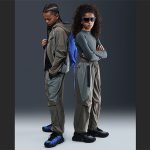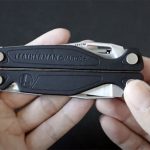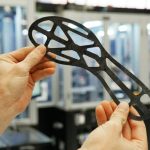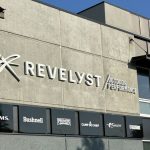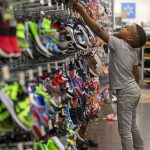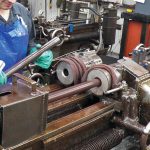Nautilus Inc. reported revenue for the first quarter of $93.7 million, up 11 percent from $84.4 million in the year-ago period, driven primarily by strong demand for strength and cardio products, including its new connected-fitness bikes.
The company said it was able to capture the accelerated demand for home fitness resulting from COVID-19 stay-at-home orders in the last few weeks of March through strong omnichannel execution.
Income from continuing operations increased to $2.3 million, or 8 cents per diluted share, compared to a loss from continuing operations of $8.5 million, or 29 cents per diluted share, a year ago. The income swing was driven by higher revenue and expense discipline and aided by the tax benefit related to the Coronavirus Aid, Relief, and Economic Security (CARES) Act.
“In the first quarter of 2020, we achieved stronger than expected financial results, including revenue growth of 11 percent, our first positive sales comp since the third quarter of 2018, and significantly exceeded our EBITDA estimates,” said Jim Barr, Nautilus Inc. CEO. “The continued momentum of our new connected fitness products and technology, as well as the strategic and operational changes instituted in the latter half of 2019 put us on track to deliver year-over-year improvement. However, when COVID-19 pandemic stay-at-home orders hit the last few weeks of the quarter, it was the agility and strong execution of the team that allowed us to maximize the opportunity provided by the surge in demand for at-home fitness products. It was rewarding to see the power of our brands, the strength of our product portfolio, and reach of our omnichannel model in action when our customers needed us most. We delivered strong results across many of our brands including our Bowflex and Schwinn lines, in both strength and cardio products.”
“As we enter the second quarter and prepare for the remainder of 2020, we know we will be navigating a rapidly changing environment. We experienced the ripple effects of the supply chain disruption caused by COVID-19 early in the first quarter and then experienced a strong spike in demand across the product portfolio as the virus hit world-wide. Although we’ve expanded production in response to continued strong demand, we carry over a significant level of back-orders into the second quarter and believe we may not be fully caught up until the beginning of the third quarter. Additionally, while the consumer side of our business is surging, the commercial side, represented by our Octane Fitness brand, is experiencing softness, as gym closures have resulted in sales declines. Lastly, like many companies, we are closely monitoring the longer-term impact the shelter-in-place orders are having on consumer sentiment and demand.”
Barr continued, “I want to thank our dedicated employees and partners for how they’ve responded to the demands of the COVID-19 pandemic, rapidly changing our work model to remote work, dealing with disruptions in their lives, but still remaining focused on solutions to meet our customers’ needs. While delivering for customers in the short-term, our team is also balancing focus on longer-term challenges. It is important to remember that we are early in the long-term transformation of our company. We are actively gaining insights and continue to address the underlying issues that caused our multi-year revenue decline. While we believe we are making strong quarter-to-quarter progress, it is possible we will not yet produce consistent linear quarterly improvements, especially considering the array of uncertain outcomes from the longer-term impact of COVID-19. However, we believe that the company’s resolve, resilience, and agility are qualities that, when coupled with well-known brands and a strong product portfolio, will allow us to successfully implement the strategies that will return Nautilus to long-term profitable growth.”
Other Q1 Highlights Compared to Q1 2019
- Operating expenses decreased by 21.4 percent to $36.2 million compared to $46.0 million, primarily due to increased expense discipline, particularly in advertising expenses which delivered strong ROI in Q1;
- Operating loss decreased by 94.5 percent to $0.6 million compared to a loss of $10.2 million; and
- EBITDA from continuing operations increased to $2.3 million compared to an EBITDA loss of $8.1 million.
Q1 Segment Results Compared to Q1 2019 | Direct Segment
- Net sales were $47.1 million, up 0.9 percent, from $46.7 million. Increased sales were driven primarily by strength products which grew 58.5 percent versus last year. Strength product sales were driven by Bowflex SelectTech weights and Bowflex Home Gyms. Cardio product sales declined by 9.4 percent as strong demand for our connected-fitness bikes, the Bowflex C6 and Schwinn IC4, were not enough to fully offset declines in our Max Trainer sales;
- As of March 31, 2020, estimated revenue expected to be recognized in the future totaled $8.0 million which represents unfulfilled consumer orders and net of current promotional programs and sales discounts;
- Gross margin rate was 51.5 percent, down from 56.5 percent, primarily driven by unfavorable product mix and higher landed product costs. Sales declined in the higher-margin Max Trainers line continue to pressure margins, while landed product costs were driven higher by tariffs and expediting shipments from our factories in Asia; and
- Segment contribution income was $1.8 million, up 139.8 percent, compared to segment contribution loss of $4.5 million. The improvement in segment contribution was primarily driven by a $6.5 million reduction in media spend, as gross profit was below last year. Advertising expenses were $13.2 million in the first quarter of 2020 compared to $19.7 million first quarter of 2019.
Retail Segment
- Net sales were $45.6 million, up 23.9 percent, from $36.8 million with strong growth coming from both strength and cardio product sales. Strength sales up 54.6 percent, driven primarily by strong demand for Bowflex SelectTech weights and Bowflex Home Gyms. Cardio sales were up 17.7 percent driven by the Schwinn IC4 connected-fitness bikes and partially offset by declines in Octane Fitness products as gym closures have begun to affect sales of commercial-grade equipment. Although numerous retailers have temporarily closed store locations due to COVID-19, Bowflex and Schwinn experienced strong year-over-year sales increases through retail partners’ e-commerce and curbside pick-up platforms;
- As of March 31, 2020, estimated revenue expected to be recognized in the future totaled $5.8 million, primarily related to customer order backlog and including firm orders for future shipments. The estimated future revenues are net of contractual rebates and consideration payable for applicable Retail customers;
- The company disclosed retail customers whose sales are greater than 10 percent of total company net sales. Amazon accounted for 13.3 percent of total company net sales in the first quarter of 2020 and less than 10 percent of total company net sales in the first quarter of 2019;
- Gross margin was 22.6 percent, down from 23.3 percent, primarily driven by unfavorable sales mix and higher landed product costs. Landed product costs were driven higher by tariffs and expediting shipments from our factories in Asia; and
- Segment contribution income was $2.4 million, up 430.9 percent, compared to segment contribution loss of $0.7 million. The improvement in segment contribution was primarily driven by higher net sales and reductions in operating expenses, partially offset by lower gross margin rates.
Tax Rate
- The tax rate for the first quarter was a positive 301.2 percent, primarily due to changes in the tax treatment of net operating losses as a result of the CARES Act. The company anticipates carrying back 2019 and 2020 losses to the 2016 and 2017 tax years and recognized $3.2 million of tax benefit, representing the 14 point tax rate differential between 2019 and 2020 and carryback tax periods, as income in the first quarter of 2020.
Balance Sheet As of March 31, 2020
- Cash, cash equivalents and restricted cash were $26.5 million, and debt was $28.1 million, compared to cash and cash equivalents of $11.1 million and debt of $14.1 million as of December 31, 2019;
- $18.0 million was available for borrowing under the Wells Fargo Asset Based Lending Revolving Facility;
- Inventory was $34.9 million, compared to $54.8 million as of December 31, 2019. The decrease in inventory was primarily due to the seasonality of the business and to the surge in demand for home-fitness products;
- Working capital totaled $60.7 million versus $40.5 million at year-end 2019 as a result of reductions in trade payables and receivables;
- Trade payables were $34.2 million, compared to $74.3 million at year-end 2019 primarily due to the seasonality of the business; and
- Capital expenditures totaled $1.7 million as of March 31, 2020. We are reiterating our full-year capital guidance range of $8 million to $10 million for 2020.
Photo courtesy Nautilus


